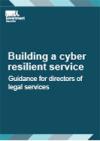| Theme |
Context |
Areas to consider |
|
Handling sensitive data
|
Due to the nature of the work your service delivers, you will be handling sensitive data on a day-to-day basis, both electronically and physically.
Your team must take extra precautions to protect the sensitive information outlined above
|
Are you aware of all the sensitive data your service holds?
How are physical notes and recorded stored or destroyed?
What systems are used to store electronic records and information?
|
| Access controls |
To ensure any sensitive data is protected, you should implement access controls and restrict access to sensitive information only to authorised personnel.
Training staff members on secure data handling is essential, and ensure they are aware of their responsibilities in protecting data.
|
Is sensitive information stored and protected in your service?
Who has access to data storage systems?
How often does you review access?
How often does training take place?
Is multi–factor authentication in use across programmes?
|
| Regular audits |
Your service should be conducting regular audits of data management practices to ensure that they comply with relevant regulations and industry standards e.g. the retention of records are complaint within GDPR timeframes.
Keep track of any changes in data protection laws and update practices accordingly.
|
How often do you audit your data management practices?
Who is responsible for organising this audit?
How do you seek assurance that effective audits have taken place?
|
|
Data protection laws
|
In the UK, we still have the General Data Protection Regulation (GDPR) and the Data Protection Act (2018).
It is your obligation to ensure that your team complies with these data protection regulations to protect your services personal data and ensure that the personal data of environmental services is collected, processed, and stored lawfully, fairly, and securely.
|
Are your team aware of the UK GDPR regulations and how they affect your work?
How often does full staff training take place and not just awareness?
|
|
Record keeping
|
The context of record keeping in this sector involves the creation, maintenance, and preservation of legal records to support effective legal management, decision-making, and regulatory requirements. |
How often do your team update records?
How are records stored and updated?
|
|
Risk management
|
Risk management processes, such as conducting regular risk assessments, implementing appropriate security measures, and developing contingency plans for data breaches, are essential to identify and mitigate potential risks to the security and privacy of data.
These risks should be added to the departmental risk register and raised to your Senior Management Team.
|
How often do risk assessments take place in your service?
What contingency plans are in place for data breaches?
Are staff aware of data breach processes?
|

